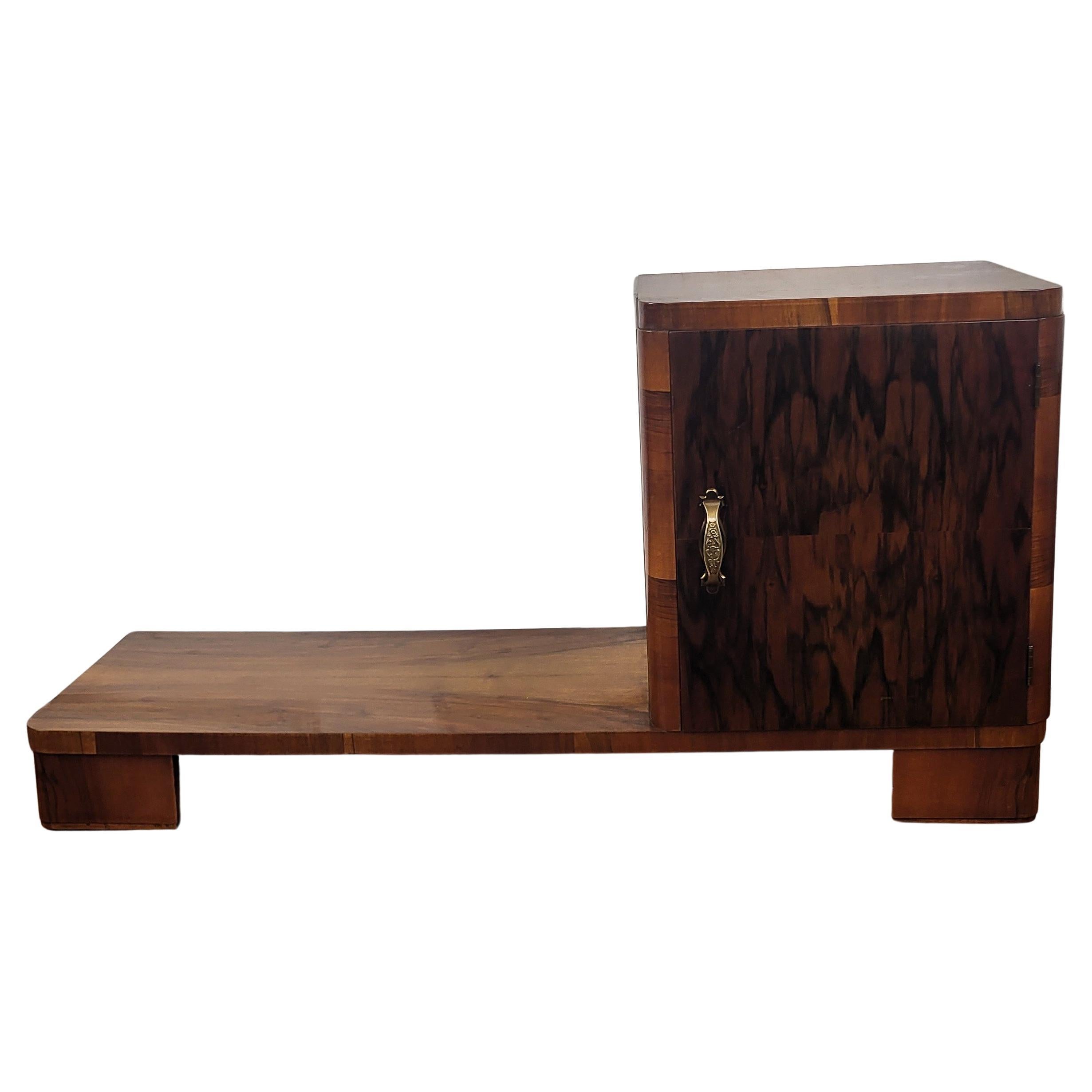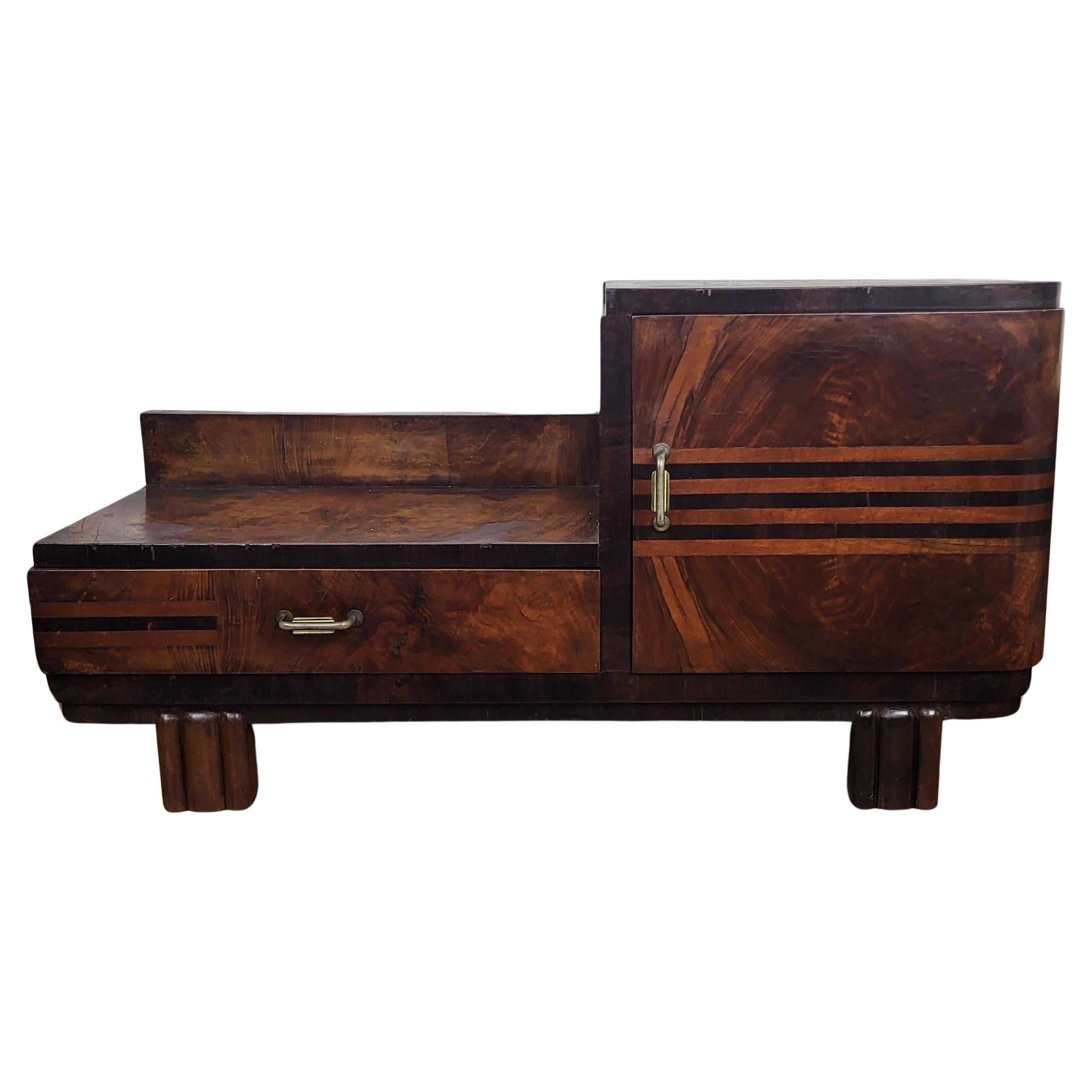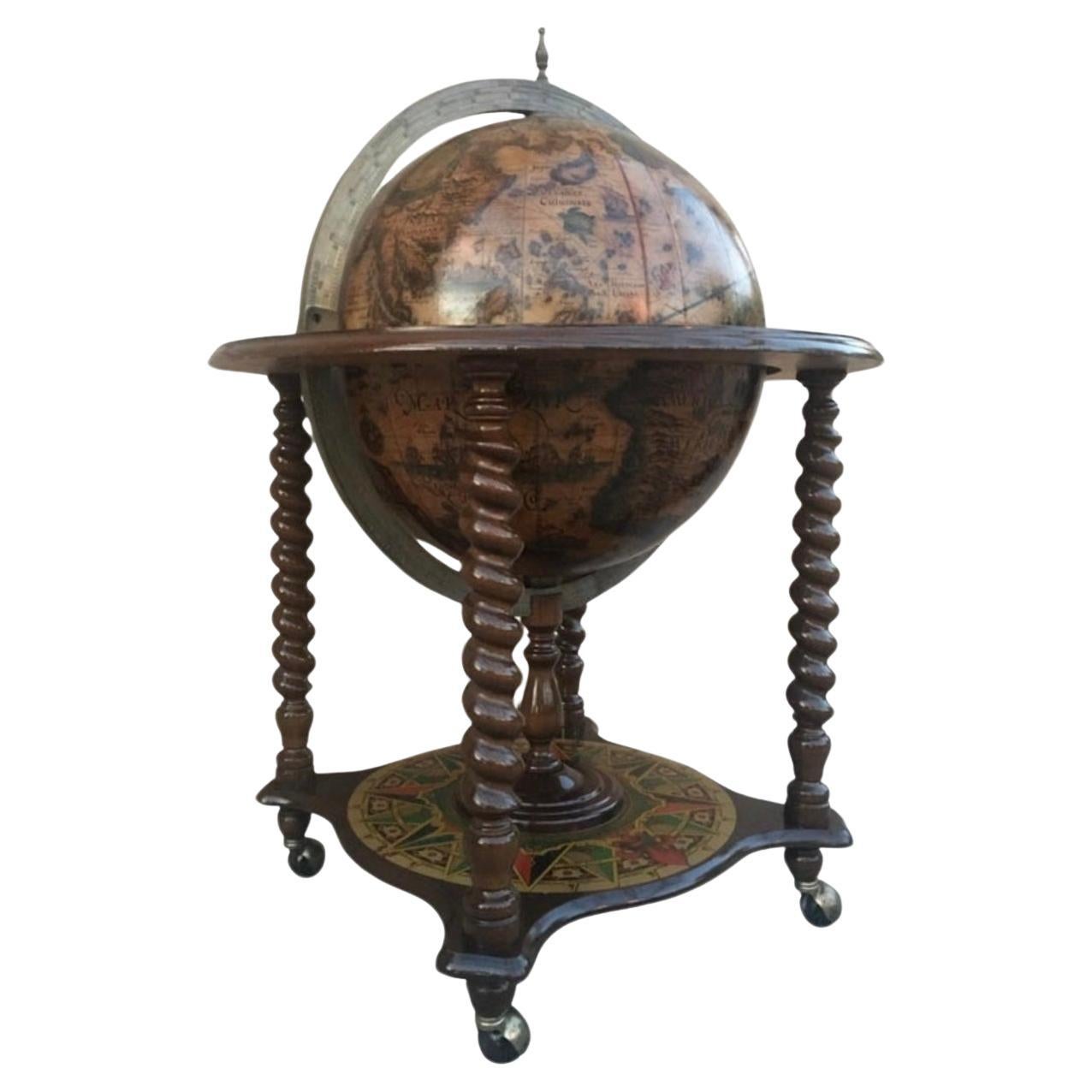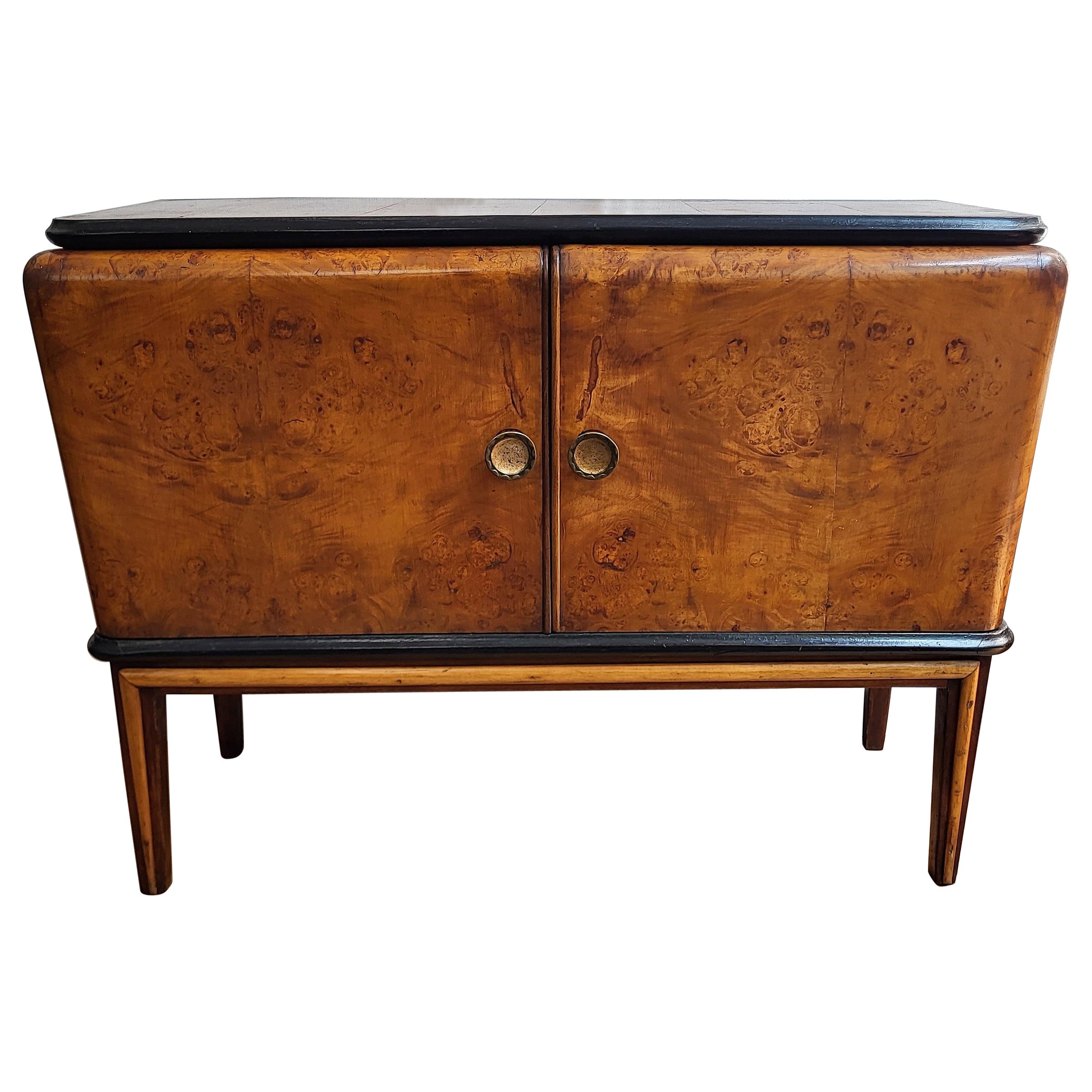Items Similar to 1940s Art Decò Rounded Cabinet Dry Bar Sideboard by A. Fallica for A. Liporesi
Want more images or videos?
Request additional images or videos from the seller
1 of 10
1940s Art Decò Rounded Cabinet Dry Bar Sideboard by A. Fallica for A. Liporesi
About the Item
Art Decò Rounded cabinet dry bar sideboard front and side doors by Alfio Fallica for Alfonso Liporesi, in white oak with illuminated upper compartment. Generous sideboard with front and side spaces, very useful for bar and lunch services. Murano glass handles. Aluminum edging.
LIPORESI, Alfonso : 1919-2001
Alfonso Liporesi was an artist, a designer and a furniture manufacturer with "Liporesi Arredamenti d'Arte, Bologna", famous above all for having created the "VENCHI" chain of shops in many Italian cities and furnishings for France, Belgium and Germany.
As an artist, Alfonso Liporesi's work has been offered at auction multiple times, with realized prices ranging from 1,679 USD to 2,713 USD, depending on the size and medium of the artwork. Since 2019 the record price for this artist at auction is 2,713 USD for Tabouret moderniste en chêne, assise circulaire concave reposant sur une base légèrement bombée entourée d'un cerclage en aluminium brossé., sold at Tajan in 2022.
As designers he is famous for his Bar Cabinet with mirrored glass inserts and marble top,1950s; also sofas, coffee tables, poofs, sold at auction for thousands of euros.
FALLICA, Alfio
He was born in Paternò (Catania) on 18 April. 1898 by Salvatore, farmer, and Maria Russo. He attended the high school of architecture in Rome and already before graduating (1931) he participated in numerous exhibitions.
In May 1925 he exhibited at the headquarters of the Roman engravers and artists group, together with Eugenio Fegarotti from Catania.
On that occasion, Fallica stood out above all for his originality and his skills as a designer: "he knows how to draw well and also excellently summarize with a personal and architectural character, avoiding the useless and abolishing conventionalism" (Scarpa, 1925, p 5). In addition to the drawings, in the same exhibition he also presented some etchings.
In 1925 he participated in the III Rome Biennial (see Il Messaggero, 1 July 1925) and in 1927 in the III International Exhibition of Monza and the II Werkbund Exhibition in Stuttgart. Furthermore, in 1927 he won first prize in the competition for the monument to the financial police in Rome. Also in Rome, in 1928 he participated in the 1st Italian Exhibition of Rational Architecture.
Among the 42 exhibiting architects only two came from southern and insular Italy: Fallica and G. Marletta from Catania (Cennamo, 1973, p. 101). Fallica presented seven projects, some of which were already under construction: the Cutore villa on Etna, the "citrus laboratory" in Paternò, the Fegarotti villa in Fregene, the Fegarotti villa in Rome, the entrance to the Plaja in Catania ( the drawing, which evokes De Chirico atmospheres, is found in Catania, with F. Mariela's daughter), the transformation of the small house owned by Cutore and David on Etna, the arrangement of the pavilion of the Chamber of Commerce in Milan, a perspective and a elevation of his study.
In the project for Villa Cutore on Etna, among the simplicity of the straight lines and flat surfaces, an excessive rigor emerges, a little chastened and "not sufficiently animated by the shadowy voids of the large openings, the external stairs, the very thin railings" ( Rocca, 1988, p. 101). In Paternò's "citrus laboratory", however, the linear forms interact with the curvilinear volumes. A more complex operation was the Fegarotti villa in Viale Bruno Buozzi in Rome, defined as a "Mediterranean interpretation of rationalist principles" (De Guttry-Maino, 1988, p. 148), in which the only historicist insertions are evident in the gables." sixteenth century" and in the pillar-tower which refers to art nouveau.
In 1929 F. designed and built the Fecarotta jewelery shop in via Etnea n. in Catania. 172 (today only the sign and a large round table, designed by him, remain). Around 1930, still in Catania, he designed Villa Caponetto, built in via Passo di Aci.
It is an eclectic architecture in which Phallica's interest in the deco taste appears evident, but also in the Palermo tradition (Arab-Norman) in the red domes and in classical culture, in the use of the cornucopia which frequently appears as the theme song for Fallica's works. Finally, it is worth noting the turret in which the original insertion of the small round balcony emerges which turns "outwards, like a tray suspended beyond the transparent body of the veranda" (Rocca, 1988, p. 102).
In 1931 Fallica graduated in architecture with Marcello Piacentini, supervisor; the following year, on 11 May, in Catania, he married Rachele Sciuto, belonging to the upper middle class of Catania, with whom he had three children: Mariela (born 20 July 1933), Livia (born 27 March 1937), Salvatore ( born 31 January 1947). In those years Fallica worked between Catania and Rome, where in 1939 he called his family. He returned definitively in 1943 to Catania, where he continued to work intensely in the field of architectural design.
In 1932, again in Catania, he created the original Etne café (see F. Fichera, in Rivista del Comune di Catania, October 1932, pp. n.n.), now destroyed, in which the painted walls presented evident deco motifs, while the monumental coffee machine evoked futuristic forms. Among the civil architecture of this period are the condominium building in via Umberto 144/D, with a rigidly square shape, and another building in piazza Jolanda 23, notable above all for the internal staircase which unfolds softly around an ideal oval pillar . The building in viale XX Settembre 29-33 from 1934 and the condominium building in via Lago di Nicito 34 denote a now fashionable twentieth-century style. However, the limits placed on F. by the clients, who tended to economize at the expense of quality and of the decorative apparatus.
Among the Catania architects of the 1920s and 1930s - C. Aloisi, F. Fiducia, R. Leone, G. Marletta and F. Fichera - F. was probably the most eclectic: in fact he also dedicated himself to furnishings, sculpture, to painting and engraving.
His activity as an interior designer and creator of furniture was better known.
ABOUT A. LIPORESI
"Liporesi Arredamenti d'Arte, Bologna" was an important furniture and furnishings manufacturing company of the 20th century. Founded by the famous architect and designer Alfonso Liporesi whose creations are well valued by furniture auction houses in Italy and abroad.
- Dimensions:Height: 59.06 in (150 cm)Width: 53.15 in (135 cm)Depth: 19.69 in (50 cm)
- Style:Art Deco (Of the Period)
- Materials and Techniques:
- Place of Origin:
- Period:
- Date of Manufacture:1940s
- Condition:Wear consistent with age and use.
- Seller Location:Vigonza, IT
- Reference Number:
About the Seller
4.9
Vetted Seller
These experienced sellers undergo a comprehensive evaluation by our team of in-house experts.
Established in 2017
1stDibs seller since 2017
283 sales on 1stDibs
Typical response time: 3 hours
- ShippingRetrieving quote...Ships From: Vigonza, Italy
- Return PolicyThis item cannot be returned.
More From This SellerView All
- 1930s French Art Decò Sideboard Buffet Dry Bar by Jules Leleu, in Walnut BriarBy Jules LeleuLocated in Vigonza, PaduaThis beautiful sideboard designed and executed by J&M Leleu, Paris (Jules and Marcel Leleu atelier), all in precious walnut briar , with interior cladding in mahogany wood, is a piec...Category
Vintage 1930s French Art Deco Dry Bars
MaterialsWalnut
- Art Deco Dry Bar Cabinet by Meroni & Fossati Gio Ponti attributed, Briar of ElmBy Gio PontiLocated in Vigonza, PaduaSmall cabinet buffet, dry bar, Art Deco period 1940 , Gio Ponti attributed per Meroni & Fossati, veneered in briar of elm with interior in mahogany . Original handless of the period....Category
Mid-20th Century Italian Mid-Century Modern Buffets
MaterialsWalnut, Burl
- Art Deco Bar Cabinet in Burl Walnut, Guglielmo Urlich Attributed, circa 1930By Meroni & FossatiLocated in Vigonza, PaduaArt Deco bar cabinet in burl walnut, Guglielmo Urlich attributed for Meroni & Fossati , Lissone-Milano . All original cabinet restored, with functioning internal lighting. The internal mirror, has parts of small mirrors oxidized, that we thought not to replace to have a 100% original cabinet. Original Murano glass handles, circa 1930. The internal compartment has a removable shelf, usable as a tray. Measures cm: H76 W82 D44 (internal H38cm). Guglielmo Ulrich (born 1904, Milan–died 1977...Category
Mid-20th Century Italian Art Deco Dry Bars
MaterialsMirror, Burl, Walnut
- Mid-Century Working Fridge Dry Bar Cart Cabinet Triennale Design Museum MilanBy IgnisLocated in Vigonza, Padua1960s working fridge bar cart cabinet exposed to Triennale Design Museum in Milan. Functional, all original and complete in every part. Measures cm: H 93 W...Category
Vintage 1960s Italian Mid-Century Modern Dry Bars
MaterialsMetal
- 1960s Dry Bar by Franco Albini per Mobili di Cantù, with Fornasetti's decorationBy Franco AlbiniLocated in Vigonza, Padua1960s dry bar cabinet by "Mobile di Cantù" attributed to Franco Albini. Black painted steel structure and externally red teak veneered cabinet and yellow teack inside. Closing doors...Category
Mid-20th Century Italian Mid-Century Modern Dry Bars
MaterialsSteel
- 1950s Italy Empire Bar Buffet, Servant Sideboard, by Federico Munari.By Federico MunariLocated in Vigonza, PaduaElegant bar sideboard in walnut with maple interiors. Designed and produced by Munari ; with internal glass shelf and two drawers, all in vitrified and inlaid maple wood finish. Two ...Category
Mid-20th Century Italian Directoire Sideboards
MaterialsMaple, Walnut
You May Also Like
- Italian 1940s Art Deco Midcentury Walnut Burl Dry Bar CabinetLocated in Carimate, ComoVery elegant Italian furniture in typical Art Deco shape and materials with its beautiful veneer walnut briar burl wood and one side door. Ideal as a side piece bar cabinet as picure...Category
Mid-20th Century Italian Art Deco Dry Bars
MaterialsBrass
- Italian 1940s Art Deco Midcentury Walnut Burl Dry Bar CabinetBy Vittorio Dassi, Guglielmo Ulrich, Gio Ponti, Paolo Buffa, Ico & Luisa ParisiLocated in Carimate, ComoVery elegant Italian dry bar cabinet in typical Art Deco shape and materials with its beautiful veneer walnut briar burl wood, one door and a drawer both framed with wood veneer stan...Category
Mid-20th Century Italian Art Deco Dry Bars
MaterialsBrass
- Art Deco Bar Cabinet, 1940sLocated in Miami, FLThis is a modernist midcentury cocktail drinks cabinet in the form of a globe, circa 1940 in date. The hinged top section opens to reveal a fitted interior with spaces for glasses an...Category
Mid-20th Century Spanish Mid-Century Modern Dry Bars
MaterialsWood
- Italian 1940s Art Deco Midcentury Walnut Burl and Mirror Mosaic Dry Bar CabinetBy Vittorio Dassi, Guglielmo Ulrich, Paolo Buffa, Gio Ponti, Ico & Luisa ParisiLocated in Carimate, ComoVery elegant Italian Art Deco Mid-Century Modern drinks dry bar cabinet in beautiful veneer walnut briar burl wood, two doors with great wooden decor craftmanship and handles. When o...Category
Mid-20th Century Italian Art Deco Dry Bars
MaterialsBrass
- Elegant Italian Art Deco Dry Bar Cabinet by Michele Merighi 1940Located in Rome, ITLarge Italian mahogany Art Deco bar cabinet designed by Michele Merighi and made by Ronconi Cantù. This cabinet is part of the dining room published o...Category
Vintage 1930s European Art Deco Dry Bars
MaterialsWood
- Italian Art Deco Sideboard with Bar Cabinet Attributed to Osvaldo Borsani, 1940sBy Osvaldo BorsaniLocated in Traversetolo, ITOsvaldo Borsani designed this beautiful Italian sideboard in the 1940s. With its unique design and excellent manufacturing quality, the sideboard stands out from the crowd. The gl...Category
Vintage 1940s Italian Art Deco Sideboards
MaterialsBrass





